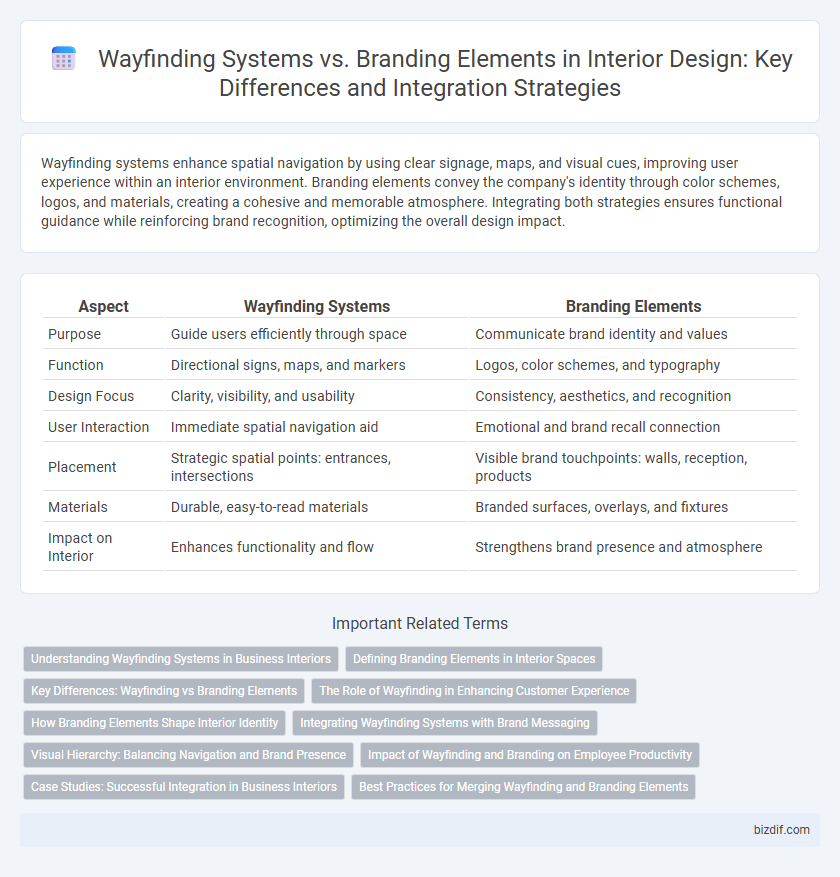Wayfinding systems enhance spatial navigation by using clear signage, maps, and visual cues, improving user experience within an interior environment. Branding elements convey the company's identity through color schemes, logos, and materials, creating a cohesive and memorable atmosphere. Integrating both strategies ensures functional guidance while reinforcing brand recognition, optimizing the overall design impact.
Table of Comparison
| Aspect | Wayfinding Systems | Branding Elements |
|---|---|---|
| Purpose | Guide users efficiently through space | Communicate brand identity and values |
| Function | Directional signs, maps, and markers | Logos, color schemes, and typography |
| Design Focus | Clarity, visibility, and usability | Consistency, aesthetics, and recognition |
| User Interaction | Immediate spatial navigation aid | Emotional and brand recall connection |
| Placement | Strategic spatial points: entrances, intersections | Visible brand touchpoints: walls, reception, products |
| Materials | Durable, easy-to-read materials | Branded surfaces, overlays, and fixtures |
| Impact on Interior | Enhances functionality and flow | Strengthens brand presence and atmosphere |
Understanding Wayfinding Systems in Business Interiors
Wayfinding systems in business interiors are designed to guide visitors and employees effectively through complex spaces, enhancing user experience and operational efficiency. These systems utilize clear signage, spatial cues, and digital directories that align with the building's layout, ensuring intuitive navigation without confusion. Unlike branding elements, which primarily reinforce corporate identity and aesthetic appeal, wayfinding focuses on functional clarity and accessibility, directly impacting customer satisfaction and safety in commercial environments.
Defining Branding Elements in Interior Spaces
Branding elements in interior spaces encompass logos, color schemes, typography, and unique design motifs that visually communicate a company's identity and values. These elements create a cohesive atmosphere, reinforcing brand recognition and emotional connection for visitors and employees alike. Strategic placement and consistent use of branding components enhance the overall user experience while supporting the company's marketing and cultural goals.
Key Differences: Wayfinding vs Branding Elements
Wayfinding systems prioritize functional clarity by guiding users through spaces using signs, symbols, and maps designed to enhance navigation efficiency. Branding elements focus on visual identity, incorporating logos, color schemes, and typography to create a cohesive brand presence that evokes emotional connections. The key difference lies in wayfinding's user-centric orientation towards spatial orientation, while branding elements emphasize marketing and aesthetic consistency.
The Role of Wayfinding in Enhancing Customer Experience
Wayfinding systems play a crucial role in enhancing customer experience by providing clear, intuitive navigation through complex interior spaces, reducing frustration and improving overall satisfaction. Unlike branding elements that primarily communicate identity and aesthetic values, effective wayfinding integrates spatial design with cognitive cues to guide visitors effortlessly to their destinations. Optimized signage, color-coded pathways, and strategic placement contribute to a seamless flow, supporting accessibility and reinforcing positive interactions within commercial and public interiors.
How Branding Elements Shape Interior Identity
Branding elements in interior design create a cohesive identity by incorporating logos, color schemes, and typography that reflect the company's essence throughout the space. These visual cues influence customer perception and reinforce brand recognition beyond traditional signage. While wayfinding systems prioritize navigation efficiency, branding elements embed storytelling and emotional connection within the environment.
Integrating Wayfinding Systems with Brand Messaging
Integrating wayfinding systems with brand messaging enhances spatial navigation while reinforcing brand identity through consistent visual cues such as logos, colors, and typography. Effective collaboration between graphic design and environmental elements ensures cohesive storytelling that guides visitors intuitively and strengthens brand recognition. This strategic fusion transforms functional signage into immersive brand experiences, boosting customer engagement and loyalty.
Visual Hierarchy: Balancing Navigation and Brand Presence
Wayfinding systems prioritize clear visual hierarchy through distinct signage, color coding, and iconography to ensure effortless navigation within interior spaces. Branding elements employ consistent logos, typography, and color schemes to reinforce brand identity without overwhelming directional cues. Balancing these components optimizes user experience by integrating navigational clarity with subtle yet impactful brand presence.
Impact of Wayfinding and Branding on Employee Productivity
Wayfinding systems enhance employee productivity by reducing time spent navigating complex office layouts, promoting efficiency and minimizing stress. Branding elements embedded within interior design foster a strong organizational identity, boosting employee morale and motivation. The combination of clear wayfinding and cohesive branding creates an intuitive workspace that supports focus and collaboration.
Case Studies: Successful Integration in Business Interiors
Case studies of business interiors reveal that seamless integration of wayfinding systems and branding elements significantly enhances customer experience and spatial navigation. Effective projects incorporate brand colors, logos, and messaging into signage, ensuring consistency and reinforcing identity while guiding visitors intuitively. Examples from industries like retail, healthcare, and corporate offices demonstrate increased engagement and operational efficiency through tailored design strategies.
Best Practices for Merging Wayfinding and Branding Elements
Integrating wayfinding systems with branding elements enhances spatial navigation while reinforcing brand identity, creating cohesive environments that guide visitors intuitively. Best practices include using consistent color schemes, typography, and logo placements that align with the brand's visual language to strengthen recognition and user experience. Strategically balancing functional signage with aesthetic branding ensures clarity in directions without overshadowing the brand narrative.
Wayfinding Systems vs Branding Elements Infographic

 bizdif.com
bizdif.com